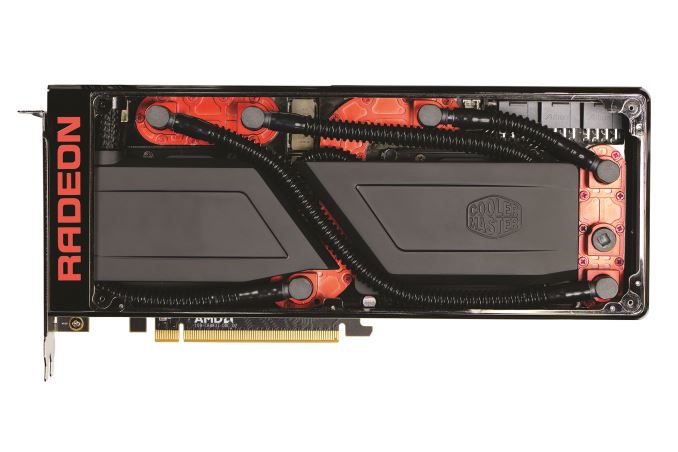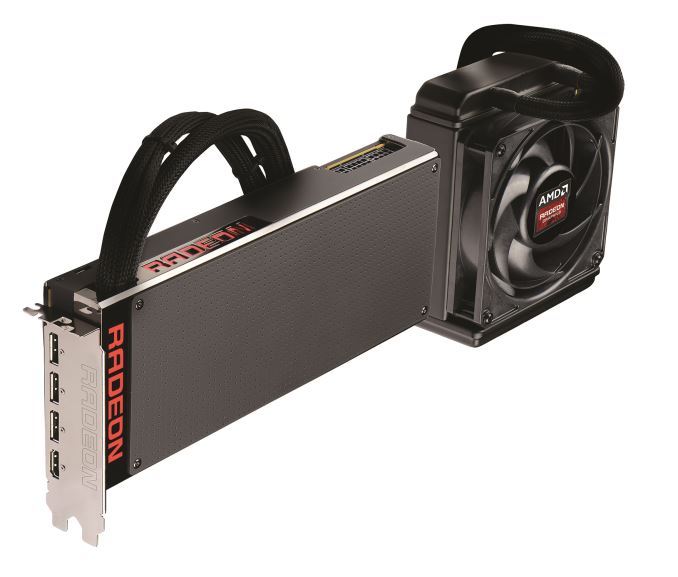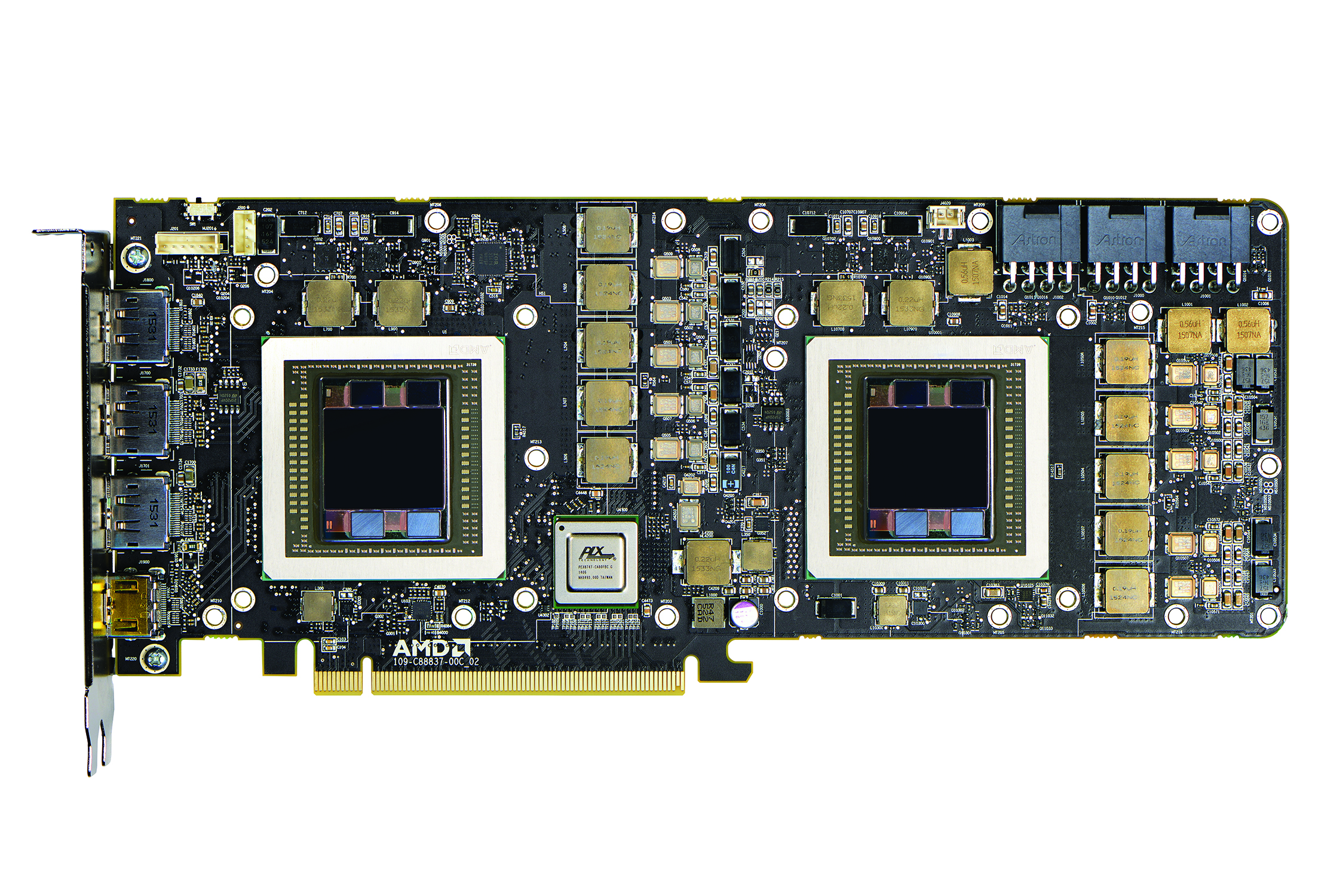AMD Releases Radeon Pro Duo: Dual Fiji, 350W, $1500
by Daniel Williams on April 26, 2016 9:00 AM EST
These recent years we have seen a slow but steady buildup of VR from both technological developments to growing enthusiasm shown by consumers and the industry. Today AMD is releasing the Radeon Pro Duo to the market as their first card targeted at VR developers. This card is not being directly aimed at gamers, despite the capability under the hood, but focuses on official support for professional software. Additionally, multiple initiatives are being both spearheaded and supported by AMD and others to encourage growth in the VR sector.
The AMD Radeon Pro Duo was first announced back in March, with the card is being marketed for VR content creation first and foremost. With this card, AMD is promoting the ability to allocate one GPU per eye while powering VR experiences. This way the case is opened up for performance beyond what any other single card can offer today. Another use case for developers is offloading compute work to the second GPU while the first is used for graphical work which can make for a much smoother experience during demanding a workflow.
Gaming is definitely possible on Radeon Pro Duo and alongside the FirePro drivers for content creators, Radeon drivers will be available. The Pro Duo will not see validation for as many applications as a true FirePro card, but official support will be provided for applications important to gaming content creation such as Autodesk, Maya, and Blackmagic Davinci Resolve.
| AMD GPU Specification Comparison | ||||||
| AMD Radeon Pro Duo | AMD Radeon R9 Fury X | AMD Radeon R9 Fury | AMD Radeon R9 295X2 | |||
| Stream Processors | 2 x 4096 | 4096 | 3584 | 2 x 2816 | ||
| Texture Units | 2 x 256 | 256 | 224 | 2 x 176 | ||
| ROPs | 2 x 64 | 64 | 64 | 2 x 64 | ||
| Boost Clock | 1000MHz | 1050MHz | 1000MHz | 1018MHz | ||
| Memory Clock | 1Gbps HBM | 1Gbps HBM | 1Gbps HBM | 5Gbps GDDR5 | ||
| Memory Bus Width | 2 x 4096-bit | 4096-bit | 4096-bit | 2 x 512-bit | ||
| VRAM | 2 x 4GB | 4GB | 4GB | 2 x 4GB | ||
| FP64 | 1/16 | 1/16 | 1/16 | 1/8 | ||
| TrueAudio | Y | Y | Y | Y | ||
| Transistor Count | 2 x 8.9B | 8.9B | 8.9B | 2 x 6.2B | ||
| Typical Board Power | 350W | 275W | 275W | 500W | ||
| Manufacturing Process | TSMC 28nm | TSMC 28nm | TSMC 28nm | TSMC 28nm | ||
| Architecture | GCN 1.2 | GCN 1.2 | GCN 1.2 | GCN 1.1 | ||
| GPU | Fiji | Fiji | Fiji | Hawaii | ||
| Launch Date | Q2 2016 | 06/24/2015 | 07/14/2015 | 04/21/2014 | ||
| Launch Price | $1499 | $649 | $549 | $1499 | ||
The Radeon Pro Duo is essentially and effectively two Radeon R9 Nanos together on a single PCB. At a high level, the Pro Duo should give us up to twice the performance at twice the power consumption (plus a bit extra for PCIe switches). To remove heat, the card comes with a closed loop cooler similar to that found on AMD’s Radeon R9 Fury X. This cooler, unlike the one found on the R9 295X2, provides a complete liquid cooling solution covering the VRMs on both GPUs along with the GPUs themselves. For reference, the pipes on this one are 540 mm long, and the double-thick radiator with fan comes in at 63 mm
Moving past the cooling solution we get three full sized DisplayPort connectors and one full-size HDMI port. On the side of the card there are three 8-pin PCIe power connectors which will do more than an adequate job of supplying the rated 350W power draw. Note that 350W is the equivalent of dual R9 Nano cards (rated at 175W a piece), and will be clocked similarly. The reactive frequency adjustments to heavily loading, by inference, are likely to be similar but we expect AMD to be using low-power binned parts for their new high-end card.
The Radeon Pro Duo is launching today at $1500, or three times the current price of the R9 Nano. That’s a $500 price premium to combine two cards into one. Even with the price, AMD is keen to admit that the Radeon Pro Duo is now the single fastest graphics card on the market since the competition doesn’t offer a similar product at this time. From our perspective at AnandTech, we still advise that users are better off investing in a single powerful GPU first, and only scaling out into SLI/CF when requirements for extreme performance are such that a single GPU solution cannot provide. With VR, it stands a good chance at pushing gaming machines harder than anything we’ve seen so far, especially when trying to maintain a smooth and low latency experience. It all depends on the workflow and subsequent frame rendering methods used.
Alongside all of this news and information is renewed attention for several initiatives AMD is taking part in. AMD has placed the Radeon Pro Duo as the first card in their AMD VR Ready Creator Line. The goal being that the Pro Duo, coupled with Liquid VR, will create a powerful and capable platform to develop future VR experiences. The AMD VR Ready Creator Line is also the platform of choice for Crytek’s VR First initiative, which intends to foster growth in the VR industry by supporting developers by powering virtual reality labs in colleges and universities around the world.
We are approaching a crossroads between the outgoing GPU generation and the upcoming cards coming out later this year. The Radeon Pro Duo is part of an outgoing generation but aims to provide a competent platform for VR content creation following known architecture guidelines. Along with the new hardware released today, there are many initiatives in motion that aim to encourage growth in VR, and new hardware will continue to be an important tool for creating innovative experiences moving forward.
We have already seen Tmall post up an early listing for an XFX variant of the Pro Duo, and retailers should be showing other OEMs variants today as well. At current, AMD's base design is expected to be the sole variant of the Pro Duo.
Source: AMD


























63 Comments
View All Comments
AS118 - Tuesday, April 26, 2016 - link
That's a good point, Crossfire / SLI has always had hit and miss support, but lately I feel like it's worse than it's been in a while, and many major releases don't support it or don't support it well enough for it to be worth it.Especially with all the bad console ports that bring top-tier cards to their knees because the developers just couldn't be bothered to port it right, even when the original game was developed for a x86 AMD APU platform that's basically just a modified PC based on older tech.
I'll admit that even with a x86 common platform it's not exactly the same, but even still, some companies seem to not even want to try, including Microsoft (the makers of Windows) of all people!
beck2050 - Wednesday, April 27, 2016 - link
Water cooling AND Crossfire? Pass. 2 custom 980tis are a much better and cheaper solution if going dual, which is never that great to begin with. This is just a marketing gimmick.HammerStrike - Thursday, April 28, 2016 - link
"...alongside the FirePro drivers for content creators, Radeon drivers will be available. The Pro Duo will not see validation for as many applications as a true FirePro card, but official support will be provided for applications important to gaming content creation such as Autodesk, Maya, and Blackmagic Davinci Resolve."The (limited) FirePro driver support is the only reason to consider this card, unless you have absolute space constraints in a SFF chassis and want the option of crossfire.
That being said, $1500 for a professional (or prosumer, in this case) card is on the cheap side, as these things go. Also, would be interesting to see if driver support for the listed programs includes crossfire support for those applications - you'd have to think it would give the nature of the card. If that's the case that's actually pretty interesting, as there is no SLI/Crossfire support in the professional space. If AMD is supporting multiple GPU's for those applications there could be some interesting niche cases where the raw performance of dual Fury X GPU's could be of use, memory limitations notwithstanding.
GerardFreeman - Tuesday, April 26, 2016 - link
You mean the 1080Ti dont you?MrSpadge - Tuesday, April 26, 2016 - link
Are they? I'm reading in the 2nd/3rd sentence:"... releasing the Radeon Pro Duo to the market as their first card targeted at VR developers. This card is not being directly aimed at gamers"
And in the next paragraph:
"... the card is being marketed for VR content creation first and foremost"
I have no idea how you can read this as "AMD is targeting the masses".
Cellar Door - Wednesday, April 27, 2016 - link
No one cares if you are a fan or not. There is no actual point in your response that has not been addressed in the article.MUATAZ - Tuesday, April 26, 2016 - link
when we expect to see High end product with 14nm ?T1beriu - Tuesday, April 26, 2016 - link
Vega 10 - Very late 2016/early 2017.nevcairiel - Tuesday, April 26, 2016 - link
Do people really expect AMD to release Polaris now and Vega in the same year?MrSpadge - Tuesday, April 26, 2016 - link
Vega is probably the same architecture in a bigger chip with HBM2, so there's no technical hurdle to release as fast as possible. You can argue that in this case they won't have enough new cards for 2017, but being quick has always payed off in the GPU business. (I'd rather bet on 2017 due to the card not being ready enough in 2016)